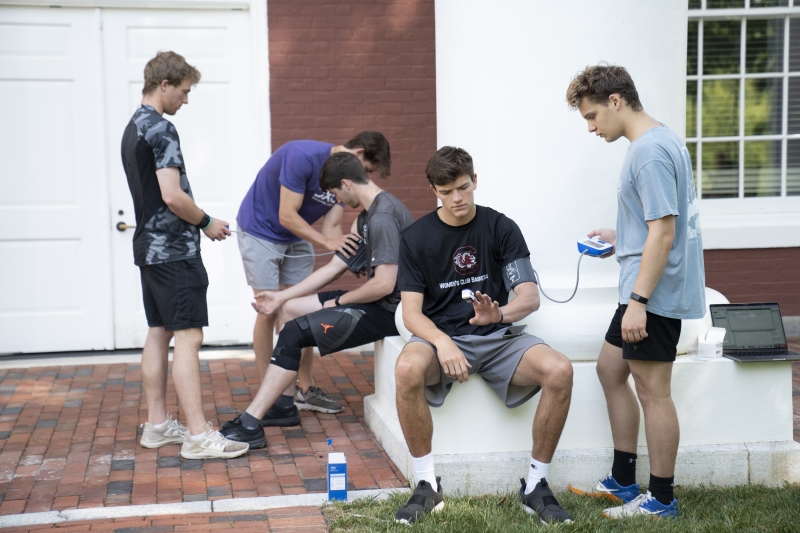Life on Two Legs In this Spring Term course, Washington and Lee students are making data science look like a walk in the park.
“We take ideas of physics and physiology and machine learning and we bring them together to understand how people move.”
~Natalia Toporikova, Assistant Professor of Biology
A group of Washington and Lee students enjoying a warm day outside on campus is not an unusual sight during W&L’s Spring Term, but passersby on the Colonnade might notice a group of students paying extra attention to their Fitbits this month. Students in the class, “A Walk Through the Ages: Using Artificial Intelligence to Understand the Evolution of Exercise,” will spend their spring days monitoring their movements on exercise trackers and investigating predictive models of exercise, movement and health impacts while exploring the evolution of human exercise.
The course, co-taught by assistant professor of biology Natalia Toporikova and assistant professor of computer science Cody Watson, explores data science through exercise metrics and includes readings on extant data from hunter-gatherer societies and the evolution of bipedalism. Watson said that the overarching goal of the course is to give students experience in predictive modeling that is informed by an understanding of the evolutionary changes that influence movement and exercise.
“Western culture has shaped our opinions on exercise and what it means to be ‘healthy,’” Watson said. “However, other cultures are bewildered at our mandates and specified times for exercise. Thus, we are exploring through discussion why different cultures have developed to have such differing opinions on the importance of exercise in our daily routines.”
Students spent their first week in the course measuring movement when walking with a focus on acceleration, calculating the human gait parameter and analyzing variations in performance. Students also learn about the different levels of organization of biological systems through readings and lab work and are exposed to a variety of coding tasks with a program called Python. Toporikova said that for her, the most valuable aspect of the course is to encourage students to take an interdisciplinary approach to thinking about the physicality of human movement.
“We take ideas of physics and physiology and machine learning,” said Toporikova, “and we bring them together to understand how people move.”
Students work in small groups to develop an experimental study based on a hypothesis about a particular exercise type, such as walking, swimming or weightlifting. The groups then use machine learning tools to develop a unique classifier that will predict the environment or physiological attributes of the subject based on data.
Toporikova and Watson are interested in having future classes conduct field work abroad, ideally in radically different terrain that will yield complex data for students to analyze. The two have not identified a preferred locale for an international component to the course, but Toporikova said it would be an interesting experiment to experience a culture in which conveniences like back-supported sitting are less common than squatting or sitting on the ground.
Jackson Gazin ’22, who is majoring in math and minoring in computer science, said the course was a natural fit for him. His future career plans include obtaining his master’s in mathematics and eventually pursuing a Ph.D. that will allow him to do research in machine learning. Watson has consulted on his thesis, “The Linear Algebraic Methods of Data Science and Machine Learning.” Gazin is particularly interested in the applications of machine learning on health care outcomes and plans to do his final project in the course on measuring and creating predictive models for running on different types of terrain.
“I like the practical stuff,” Gazin said of the course material. “I’ve learned a lot about health that I thought I would know but didn’t.”
Other groups will do final projects that examine the optimal weight and exercise regime for a weightlifting program, the relationship between heart rate and calories burned, the effectiveness of high intensity interval training, and predictive models for running on varied terrain. All groups will be using exercise trackers and collecting data throughout the term to inform their projects. Watson said the applications of the class extend beyond the science of movement.
“Students can learn a variety of skills, specifically how to extract and model data from real world scenarios,” Watson said. “They learn to process data that is unformatted, unlabeled and subjected to the issues that are inherent with human recordings.”
Senior lacrosse player Teddy Bentley ’22 said he thinks the class will inform how he approaches his own exercise habits. “I definitely monitor my exercise on my own already,” Bentley said. “On a personal level of just monitoring exercise while being a lot more knowledgeable, I think this will be very helpful in the future.”
 Students track movement during various exercises.
Students track movement during various exercises. The class conducts an experiment on the Colonnade.
The class conducts an experiment on the Colonnade.
You must be logged in to post a comment.